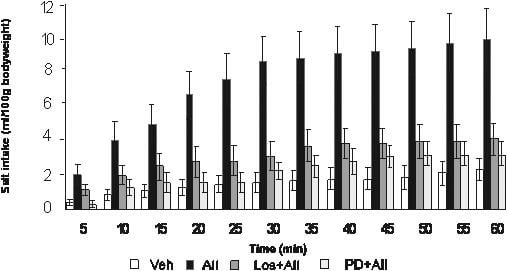The zona incerta (ZI) and the renin-angiotensin system in the brain play a definitive role in the regulation of fluid balance, thirst and hunger for NaCl. Angiotensinergic axon-terminals converge on the surface of the ZI from the circumventricular organs, providing information on the homeostatic state of the periphery, and from brain structures inside the blood-brain barrier. Angiotensin receptors (AT1, AT2) are also found in the ZI. Earlier experiments showed angiotensin II (AII) and III (AIII) microinjected into the ZI have dipsogenic effects, but via different receptors (1,2). This has been further investigated. Using the two-bottle test procedure (3) intake of water and NaCl (0.15 M) was studied in male Wistar rats (280-330 g) during a 1-week habituation period. Animals were then anasthetized (80 mg ketamine + 20 mg diazepam/kg b wt, i.p.) and bilateral stainless steel guide cannulas (22 gauge) implanted stereotaxically 0.5 mm above the ZI (Paxinos and Watson: AP: -3.3 mm caudal to bregma, ML: 1.2 and DV: 6.4) and attached to the skull. 7 days after surgery, animals underwent the same daily drinking regimen. The volumes consumed (ml/100 g b wt) were determined every 5 min for the 60-min drinking period following injection into the ZI of AII (100 ng, 95.6 pmol) and III (200 ng, 214.8 pmol) or vehicle (Veh: 0.15 M saline solution). Food was available ad libitum, but water and NaCl solution only during the drinking period. Water and NaCl consumption in angiotensin- and Veh-treated rats was compared. Finally angiotensin receptor antagonists were tested on AII- or AIII-induced fluid intake. Animals were humanely killed at the end of the experiment. During habituation animals always prefered water to NaCl solution. In the first experiment AII increased preference for NaCl compared to water (1.94±0.55 vs. 0.46±0.18) from the 5th min (means±S.E.M., ANOVA). During the first 35 min of the drinking period water intake decreased in AII-treated compared to the Veh-treated rats (0.46±0.18 vs. 1.63±0.25). In the second experiment sodium intake increased in AIII-treated compared to Veh-treated rats but this was significant only after 45 min (4.83±0.98 vs. 1.69±0.58) and was not at the expense of water intake (2.99±0.53 vs. 0.57±0.37 from the 5th min). AIII-injected animals ingested nearly the same amount of water as the Veh-injected ones, AIII-treated animals drank more water only at the 5th min (2.99±0.53 vs. 1.63±0.25). In further experiments, rats were injected with losartan (90 ng, 195.2 pmol), an AT1 antagonist or PD 123319 (180 ng, 244.3 pmol), an AT2 antagonist, 15 min before injection of an agonist. The increase in NaCl ingestion induced by AII was blocked by both antagonists but that invoked by AIII was blocked only by PD 123319 (Figs 1 and 2). The effects of AII, AIII, losartan and PD 123319 on NaCl hunger have not previously been tested in the ZI. The finding that NaCl intake increased after both AII and AIII injections but was blocked differently by the antagonists in two-bottle tests suggests that AT1 and AT2 receptors in the ZI play partially different roles in the regulation of NaCl and water intake.
University of Bristol (2005) J Physiol 567P, PC194
Poster Communications: Angiotensinergic mechanisms regulating NaCl and fluid balance in the zona incerta
Bagi, Eva Eszter; Fekete, Eva; Toth, Krisztian; Lenard, Laszlo;
1. Neurophysiology Research Group of the Hungarian Academy of Sciences at the Institute of Physiology, Pecs University, Faculty of Medicine, Pecs, Hungary.
View other abstracts by:
Figure 1. Effects of AII.
Figure 2. Effects of AIII.
Where applicable, experiments conform with Society ethical requirements.


